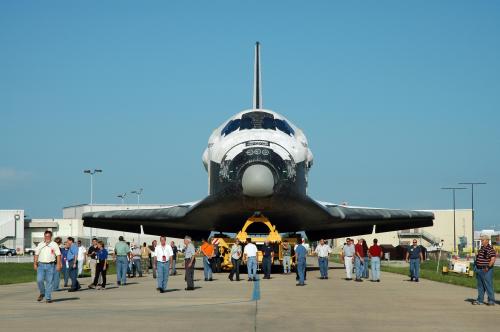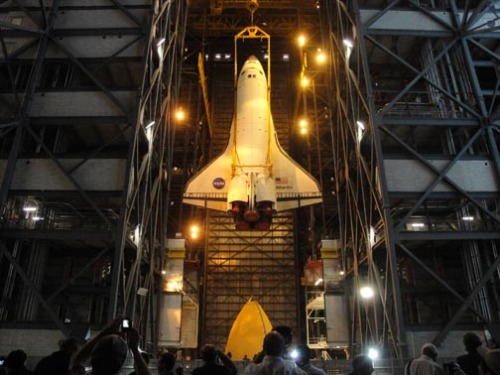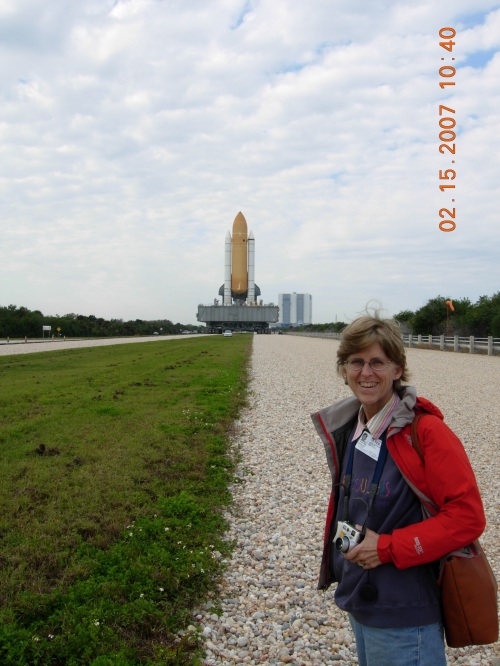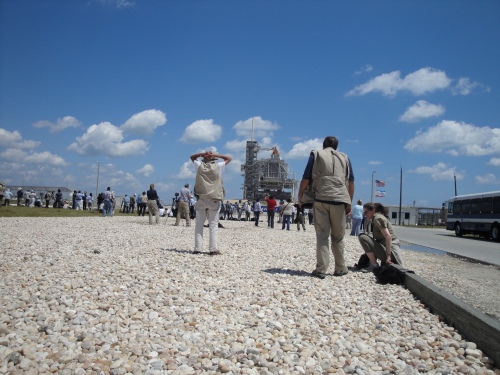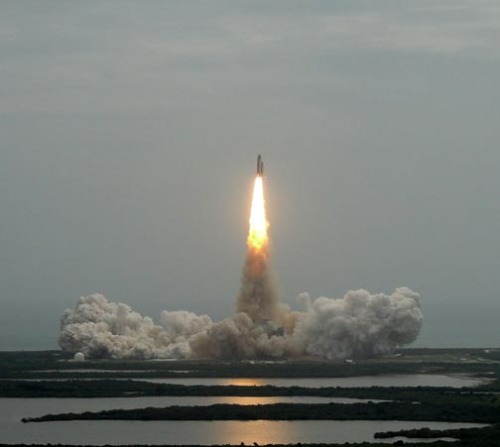
Hatch closing is a matter of life and death so much care is taken. This is the hatch that leads to the shuttle. With no more shuttle missions, and no more shuttles, it will be a long time before this hatch is opened again. Note the model of the shuttle in the upper left, and the American flag attached to the hatch. That flag flew on STS-1 and returned to Earth only to be brought back on STS-135. When Americans again dock here in their own vehicle this flag will be returned to Earth. The flag is likely to be here a very long time.
. For two days after launch on July 8, 2011,the shuttle Altantis chased after, and finally docked with the International Space Station for a final time.
The crew of four, eminently likeable people, spend the following eight days as first longshoremen, hauling about 9,000 pounds of supplies onto the ISS, and then as trashmen, hauling out 5,400 pounds of trash, stuff that had stopped working and, incredibly, 25-percent of their entire load: packing foam. When they arrived the shuttle and its bay was packed with goodies and when they closed the hatch on Monday morning sealing themselves back onto the Atlantis, they had an equal amount in volume (although not in pounds) that they had brought up.
The press, present in huge numbers for the final launch in Florida, didn’t bother to follow the mission to Houston. Six of the 3,000 accredited reporters were here. A couple of others used the phone bridge and called in each day for the press conferences. That was it.
Life in Houston. With an exception or two, the reporters in Houston, like those in Florida, were young, but very knowledgible. They represented mostly dot.coms who are space sites. One network reporter was here; another called each day from Florida. I was the only newspaper, although occasionally a F.orida news reporter would call in and ask a question or two.
In truth, there was not a lot of reason to be here.
NASA was running events on the ISS and the Shuttle 24/7 so anyone could be right up to date from anywhere in the world. They did not, of course, have a scuttlebutt in the hall or pick up tidbits that first could be known here, and sometimes not known anywhere else. But it was minor stuff. At one point on day eight the NASA public relations staff scuttled a press conference on a Saturday afternoon figuring no one would show, and considered canceling the one the following day only to be surprised that all the reporters (remember that is only six) showed up.
Press conferences, moreover, were oddly public, on TV, and then when the lights went off, reporters would gather with whoever was doing the briefing and the discussions sometimes would go on and on, as it did on Sunday.
What most intrigued me, I suppose, was the all encompassing nature of the mission here. NASA TV was on everywhere around JSC and the surrounding area. The local TV stations have NASA-TV on their cable channel lineup. And because of the nature of life on the ISS, reporters (me included) gradually lapsed into a life where day or night mattered less and less.
The shuttle circles the Earth roughly every 90 minutes, half in darkness and half in the sunlight. Languidly the Earth slowly rolls by 235 miles below — first over the Red Sea, then New Zealand and the Hudson Bay, each orbit slightly different than the last. It began to mesmerize me — the silence. The beauty. I longed to have a video tape of it to play in our home — hour after hour of grand elegance.
As the mission went on the crew was awakened earlier and earlier until, no longer getting up in the middle of the night, the day was beginning at 11 pm and then 10. The press site too followed the crew hours. First it opened at 4 am, then 3 and 2 am — and finally at midnight and continued to track earlier each day. The press conferences gradually eased back into the early hours of the day as well.
As the mission went on, I began to sleep in snatches, always with NASA-TV on, or sitting at my desk in the press site working, watching. Hotels follow a more rigid schedule and like their guests to leave at a certain time, but as the days passed one hotel’s front desk clerks began to befriend me and I to befriend them. They were fascinated by the shuttle and by NASA but, as is often true, they had never been allowed on Johnson Space Center. I brought them reporter’s notebooks and DVDs. They put me in a suite and began sliding their hotel hours later and later to accommodate my schedule.
And when I couldn’t make their computers work, I was taken into the back office and given access to their computers — and here, then, I asked about one of the clerk’s life, and he began to ask me about mine.
. . . . . . .
Coming home. The shuttle cannot remain in space for long due to its limited amount of energy. Because the shuttle launched on its first attempt, it retained enough energy to stay up an additional day — crucial in terms of packing out additional trash.
By Monday morning, NASA was eying the weather in Florida, and eying the energy levels left on the shuttle. When Atlantis left the space station she had 4 days and 13 hours of energy left, but of that NASA will use two days of energy just to get the shuttle in position to land, and as for the other two days, they do not use them. They are for the direst of circumstances to insure that the shuttle will have enough energy, and time (two days) to land if unexpected things happen and need to be straightened out.
One reporter asked, given that the shuttle is scheduled to land before dawn when no one, including nASA itself, gets much in the way of pictures, if NASA had considered sending the shuttle around an extra orbit to allow the sun to come up on Thursday.
“We don’t think that way,” was the answer. NASA wants the shuttle down as soon as possible once she leaves the ISS.
. . . . . . . .
Why was I at home on the International Space Station? I was at home on the ISS because in one sense, I have been there and spent time roaming around. That’s why I gradually slipped more and more into life on the ISS as the mission went on; I know what is where on the ISS.
NASA took me on board in Houston on June 1, 2011 and set me free. So …
Direcly ahead? The Russian sector. To my left, the Japanese laboratory. Straight ahead, through the hatch, the shuttle is docked and, look up, that is the back of the shuttle, and look down and there is its nose. I’ve crawled from the shuttle’s mid deck through to the shuttle bay to the other side of that very hatch.
The Europeans? They are over there. And …
On July 1, 2011, JSC walked about eighty members of the press, me included, past and often right through their mockups in Building 9 at JSC — the shuttle, the Soyuz, the onboard bathroom, and the entire mockup of the International Space Station itself.
These mockups, we were told, were exact replicas. The astronauts train here for familiarization.
After watching STS-135’s crew on the ISS they have me convinced.
I knew where I was — although sometimes I had to think “now where is …?” Unlike a house with steps, the ISS has different pods attached here and there almost haphazardly because, in the weightlessness of space, there’s no reason for stairs, and so there’s no reason not to attach new stuff everywhichway to the main ISS.
And so they did.
On the day before landing the shuttle commander took a videocamera and roamed the entire ISS (with the exception of the Russian area). This was like my final exam. I may have thought I’d known all week where I was, but did I really? I was quietly surprised. Yeah, I knew what was around that corner. Yeah — look up. There it is … a hatch. I knew it was there … and …
It was eerie, but stangely comforting.
I longed to be weightless and to float free.
. . . . . . . . .
What I do. I long ago decided that while I always report the basic facts hen I’m covering an event, what I’m really interested in is who has shown up. At the political conventions, it is the party officials who get those awful seats high in the eaves, or the people in the streets holding signs.
That’s where I head. That’s who I want to talk to.
The almost-Astronaut. Waiting in line to fly to Houston I strike up a conversation with a woman ahead of me with a NASA sticker on her luggage. “Does she work for NASA?”
“No — I was one of the 12 finalists to be one of the teacher astronauts, but I didn’t make it. They only selected three.”
I was impressed. Did she go through the training?
She did — she rode weighless on the vomit comet and had the $40,000 NASA physical.
“Forty-thousand dollars for a physical? What did they do?”
“You don’t want the details — really you don’t.”
She was philosophical. She knew all the places at NASA I knew — the mockups and the training facilities. She sincerely liked all of the other finalists and seemed genuinely happy for those selected. “They all spoke Russian so it would have been a plus.”
I asked her if they might call her back later since she was not merely one of the finalists, she was one of the stand-bys if someone dropped out.
“I don’t think so. They have never selected someone over 44 and now I’m over 44. No — I think it is over, but it was a great experience.”
Wait! This woman is over 44?
“Take a closer look.”
I already had. She didn’t look “over 44” to me.
The hotel clerk. A hotel clerk spies my media credentials. I’m vaguely embarrassed — I always try to remember to remove them before I leave the car. For one thing, that means I always know where they are, but mostly it is because I don’t like to draw attention to myself.
I’m here on business, but it doesn’t matter what my business is.
But I had forgotten to pull my credentials off and sow them, and he asked me about how it was to cover the shuttle, and how long I’ve covered launches. After we chat for awhile a second clerk, a woman, joins us — and eventually I go find them some momentos which are handed out to the press free. They are thrilled.
Later I ask the clerk about himself.
He works at the hotel part time and has three young daughters. He is an X-ray technician and learned his skills in the Army. His father was a career officer. The more I talk to him the more I like him.
I ask him whether he had been sent to Iraq — and he said he had several tours there, and also Afghanistan. I ask him if he is okay because what you see in war can harden and deaden you. “Yeah,” he says, “I’m okay” and then he adds that he was trained in airborne assault “so I knew what I might get into.”
What did he get into?
“911 — I was airlifted to Ground Zero less than three hours after it happened and our unit went down onto the streets by ropes. We didn’t land.”
Whoa.
“The streets were so hot that in three days I burned off the souls of four pairs of boots — the souls would get stock in the streets.”
These were stories I’d never heard before.
“We lived in Central Park,” he said, at first under the stars. By the end of September 11, 2001, the US military had 15,000 troops surrounding the ground zero site. The stink. Three and a half months later when they pulled me out, the stink was still there. No — it was worse. It was rotting human flesh. I knew what the stink was …”
Read Full Post »
 A contest was held to design a crest for the entire shuttle program. This was the crest selected and it was then placed on commemorative pins and other memorabilia.
A contest was held to design a crest for the entire shuttle program. This was the crest selected and it was then placed on commemorative pins and other memorabilia.










